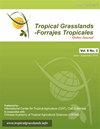森林牧区Piatã草牧场肉牛生产
IF 0.7
4区 农林科学
Q3 AGRICULTURE, DAIRY & ANIMAL SCIENCE
引用次数: 5
摘要
热带肉牛生产涉及动物在阴凉和生物多样性的环境中放牧,周围环绕着高质量的可食用生物质,这是通过银棚系统(SPSs)实现的。然而,随着时间的推移,有必要评估树木对饲料和动物生产性能的影响。在巴西塞拉多(Cerrado),我们评估了2种桉树密度(8年树龄SPS22: 227棵/ha;SPS14: 357棵/公顷)对毛斑草草料形态、产量和营养价值的影响。BRS Piatã在2015年至2016年的一年中,与纯草牧场相比,Nellore小母牛的草加性能。一方面,与纯草牧草相比,SPSs提高了饲料的营养价值(P<0.001),表现为粗蛋白质和消化率较高,中性和酸性洗涤纤维浓度较低。纯草草地的牧草质量和积累速率均高于SPSs (P<0.001)。随着乔木密度的增加,饲料生长和动物产量下降。随着年龄的增长,来自树木的竞争加剧可能是限制牧场和动物生产的严重问题,应该加以监测。桉树在建立第8年后是否适合种植可能存在疑问,需要进一步研究。本文章由计算机程序翻译,如有差异,请以英文原文为准。
Beef cattle production on Piatã grass pastures in silvopastoral systems
Tropical beef cattle production involving animals grazing in a shaded and biologically diverse environment, surrounded by high-quality edible biomass, is achievable through silvopastoral systems (SPSs). However, it is necessary to assess the effects of the presence of trees on forage and animal performance over time. In the Brazilian Cerrado, we evaluated the effects of 2 densities of eucalyptus trees in 2 SPSs (8 years of age SPS22: 227 trees/ha; SPS14: 357 trees/ha) on forage morphology, production and nutritive value of Urochloa brizantha cv. BRS Piatã grass plus performance of Nellore heifers, compared with a grass-only pasture, over a year from 2015 to 2016. On the one hand, SPSs improved (P<0.001) forage nutritive value as reflected in higher crude protein and digestibility and lower neutral and acid detergent fiber concentrations compared with a grass-only pasture. On the other hand, the grass-only pasture had higher (P<0.001) herbage mass and accumulation rate than the SPSs. Forage growth and animal production decreased with higher tree density. Increasing competition from trees with age could be a serious issue limiting pasture and animal production and should be monitored. The suitability of eucalyptus trees for planting in SPSs may be questionable after the 8th year of establishment and further studies are warranted.
求助全文
通过发布文献求助,成功后即可免费获取论文全文。
去求助
来源期刊

Tropical Grasslands-Forrajes Tropicales
Agricultural and Biological Sciences-Agronomy and Crop Science
CiteScore
1.60
自引率
0.00%
发文量
36
审稿时长
16 weeks
期刊介绍:
The Journal publishes, in English or Spanish, Research Papers and Short Communications on research and development, as well as contributions from practitioners (Farmer Contributions) and Review Articles, related to pastures and forages in the tropics and subtropics. There is no regional focus; the information published should be of interest to a wide readership, encomprising researchers, academics, students, technicians, development workers and farmers.
In general, the focus of the Journal is more on sown (''improved'') pastures and forages than on rangeland-specific aspects of natural grasslands, but exceptions are possible (e.g. when a submission is relevant for a particularly broad readership in the pasture and forage science community).
The Journal will also consider the occasional publication of associated, but closely related, research in the form of an additional scientific communication platform [e.g. a re-make of the former Genetic Resources Communication series of the former Division of Tropical Crops and Pastures of the Commonwealth Scientific and Industrial Research Organisation (CSIRO), Australia].
Areas of particular interest to the Journal are:
Forage Genetic Resources and Livestock Production[...]
Environmental Functions of Forages[...]
Socio-economic Aspects[...]
Topics within the aforementioned areas may include: Diversity evaluation; Agronomy; Establishment (including fertilization); Management and utilization; Animal production; Nutritive value; Biotic stresses (pests and diseases, weeds); Abiotic stresses (soil fertility, water, temperature); Genetics and breeding; Biogeography and germplasm collections; Seed production; Ecology; Physiology; Rhizobiology (including BNF, BNI, mycorrhizae); Forage conservation; Economics; Multilocational experimentation; Modelling.
 求助内容:
求助内容: 应助结果提醒方式:
应助结果提醒方式:


